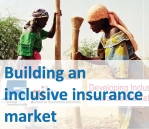What is microinsurance?
Microinsurance is a mechanism to protect poor people against risk (e.g. accident, illness, death in the family, and natural disasters) in exchange for payments tailored to their needs, income, and level of risk. It is aimed primarily at the developing world´s low-income workers, especially those in the informal economy who tend to be underserved by mainstream commercial and social insurance schemes.
Microinsurance allows policyholders to recover and rebuild after a crisis. It can mean avoiding difficult, often devastating risk coping measures such as putting children to work, eating less food, or selling productive assets. It promotes resilience and contributes to the Millennium Development Goals, including reducing hunger and child mortality, and improving maternal health.
In the event of shock, the benefits of microinsurance go beyond financial help as it can:
- Reduce risk: Insurance can play a critical role in reducing risk, since insurers have an incentive to prevent risks from occurring;
- Stimulate productivity and asset accumulation: The working poor invest more in their livelihoods, and get higher returns, if they are protected by insurance. They can also build savings through a long-term life insurance policy;
- Deliver tangible benefits: Insurance with tangible benefits, such as a hot line for medical advice or health camps that provide vaccinations and mosquito nets, can make a huge difference in the lives of millions.
Recent developments and challenges
The dynamic microinsurance sector has changed dramatically in recent years, with many encouraging results.
- Growth: Today microinsurance covers half a billion risks, up from 135 million in 2009, largely due to collaboration with national governments, but also because of more active interest by commercial insurers. In 2011, 33 of the world’s 50 largest insurance companies offered microinsurance, up from just seven in 2005.
- New delivery channels: Growth is partly attributed to the emergence of alternative delivery channels – including retailers, utility and cell phone companies, cooperatives, and labour unions – which provide new access points to reach the low-income market.
- Demonstrated business case: Microinsurance can be profitable under certain circumstances. Group insurance schemes are generally viable, as are products that are bundled with other services (e.g. loans, mobile phone minutes or fertilizer). It is more difficult for voluntary insurance to generate a surplus, particularly when covering health and agricultural risks.
- Impact: Research has demonstrated a positive impact of insurance on the lives of the poor and, more broadly, in their communities. For instance, health insurance can reduce out-of-pocket expenditure and increase use of health services. Property insurance, on the other hand, allows entrepreneurs to take more risk and invest more in their businesses. Furthermore, various studies demonstrate a causal link between the development of the insurance industry and national economic development by putting a price on risk and supporting entrepreneurship. Indeed, it is not possible to have meaningful social and economic development without insurance.
Despite recent developments, the insurance industry in many countries is not achieving its potential. Millions of poor households still lack access to good-value products. The unwillingness of insurers to participate in emerging markets has significant ramifications for the insurance industry itself as well as the global economy. A range of challenges and market failures still inhibit the development of inclusive insurance markets.
- Patchy progress: Microinsurance is developing rapidly in countries such as India, South Africa, and the Philippines, serving tens of millions of low-income households. Outreach in many other developing countries remains meagre. There is an urgent need to accelerate the development of many more markets.
- More innovation: Even in mature markets there remains significant scope for innovations to enhance efficiency, expand outreach, provide better benefits, and pay claims quickly.
- Reinventing the wheel: The lessons and experiences most evident in mature markets are slow to reach practitioners elsewhere. Consequently, market development is protracted as practitioners often repeat the same mistakes.
- Regulation and policy: The regulatory environment in many countries is not able to accommodate innovative products or alternative distribution channels.
- Specialized expertise: More skilled insurance professionals who understand the needs and preferences of the working poor are needed.
- Financial literacy: To stimulate demand, it is necessary to help the poor appreciate the value of insurance.
Given these challenges, a more holistic approach involving the full range of stakeholders is needed: this is where the work of the Microinsurance Innovation Facility fits in.












